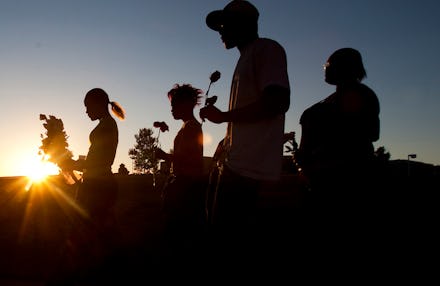A New Report Reveals a Disturbing Trend With Mass Shootings in America

The news: A new report from Everytown For Gun Safety highlights a chilling trend in the United States: Americans have experienced around two mass shootings (involving four or more deaths) each month since January 2009.
Everytown's analysis of FBI data between 2009-2012 and media reports is quite comprehensive. Here are the major points:
1. Domestic and family violence plays a bigger role in mass shootings than you probably think. In the latest analysis, 57% of mass shooters killed current or previous romantic partners or family members in the shooting, a significant jump from 40% in their previous report. Disturbingly, at least 18% of the shooters had a previous domestic violence charge, yet were still able to acquire a firearm. Everytown notes that federal law only prohibits people convicted of domestic violence from buying or owning a gun if the victim is a former or current spouse, co-resident in the same domicile, or had a child with the perpetrator. This might be a dangerous loophole allowing violent people to access a gun.
2. The idea that gun-free zones encourage shooting sprees isn't backed up by the facts. Seventy percent of the incidents took place in private residences. The 33 incidents that took place in public locations actually occurred in places where some form of concealed firearm possession was more likely to be legal, with 18 of these incidents taking place in such areas. No more than 15 of the shootings, just 14% of the total, took place in "gun-free" zones where all firearm ownership was prohibited.
Here's some further evidence to support this point. Last year, Media Matters noted that response rates to mass shootings are generally within minutes of the first shot fired. During the September 2013 Navy Yard shooting which claimed 13 lives, for example, local police arrived within two to three minutes and members of the Yard's armed security force had already fired at the shooter but failed to stop him. In 2012, Mother Jones found absolutely no evidence that even a single mass shooter had considered whether someone in the area could legally be carrying a firearm. Instead, shooters choose locations based on their personal connection to the site — and don't seem to care much about whether someone might be firing back at them. Perhaps that's because many mass shooters are suicidal; Everytown says that in 42% of incidents, the shooter killed themselves.
3. Females are equally likely to be targets, while the shooters are nearly exclusively male. Thirteen percent of gun homicide victims nationwide are female. But 51% of mass shooting victims are women. Just seven of the accused shooters were women and of those, several worked with a male. In many of the shootings, a parent murdered his or her spouse as well as any children present.
4. Shooters are getting guns when they shouldn't. In the 86 incidents where Everytown could judge whether or not the perpetrator was legally allowed to own a firearm, 42% were legally barred from firearms ownership.
5. Mass shooters are older, on average, than most shooters in gun homicides. The average age of a mass shooter is 34, compared to 26 in the general group of gun murderers; 40% were between the age of 30 and 40.
6. Assault weapons and high-cap magazines are easier to use to kill lots of people. These weapons, which are extremely dangerous in the wrong hands, were used in just 14 (13%) of the incidents. But when people go on killing sprees with more firepower, they kill more people than if they'd had a shotgun or a revolver. Shootings involving assault weapons had 156% more victims, while 63% more people died. The report does not mention how Everytown defined an assault weapon.
7. Mass shootings comprise a small minority of gun violence. Obviously mass shootings involve more victims per incident by definition. But less than 1% of gun murder victims were killed during such an incident.